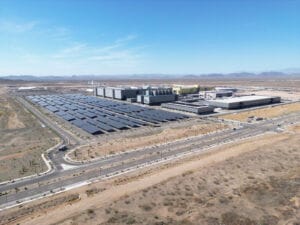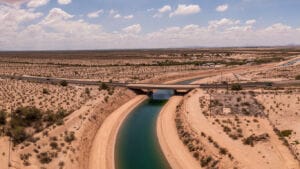On Feb. 10, 2022, the U.S. Departments of Transportation and Energy announced that nearly $5 billion will be made available to states over five years as part of the Infrastructure Investment and Jobs Act. Arizona is expected to receive approximately $76.5 million over that period to help create a national electric vehicles (EV) charging network.
U.S. Transportation Secretary Pete Buttigieg says, “A century ago, America ushered in the modern automotive era; now America must lead the electric vehicle revolution. The president’s Bipartisan Infrastructure Law will help us win the EV race by working with states, labor and the private sector to deploy a historic nationwide charging network that will make EV charging accessible for more Americans.”
According to the Department of Energy’s Alternative Fuels Data Center, Arizona currently has 873 public charging stations and ranks seventh in the nation for adoption with its 28,770 registered EVs. One of the people helping Arizonans drive electric is Jason Church, COO for Courtesy Automotive Group.
READ ALSO: How ElectraMeccanica’s $35M Mesa factory fuels Arizona’s EV boom
“We’ve been EV focused since the Chevy Volt first came out in 2011. We got behind that in a big way and sold a whole ton of those vehicles,” he says. “As our dealership group has grown from Courtesy Chevrolet to Courtesy Kia, Chrysler and Volvo, we’ve discovered that every manufacturer wants to be EV-centric now.”
Volvo spun off a separate company to lead its foray into EV production called Polestar. As a Volvo dealer, Church had the opportunity to bring a Polestar retail location to Scottsdale Fashion Square, where folks can custom order a Polestar vehicle and have it delivered to their home. Other automotive companies such as General Motors, Volkswagen and Toyota have pledged to exclusively manufacture EVs in the coming years.
To that end, General Motors announced in February 2022 that it is hiring several hundred employees for software-based positions at its Arizona Information Technology Innovation Center in Chandler. The center’s work will, as the company states, “tackle solutions and services redefining GM’s products as the company moves toward an all-electric future.”
Church adds, “When major manufacturers start using their most powerful brands and associating them with EVs, it’s no longer an experiment,” he says. “Most automakers are committing to EVs and building factories to produce them.”
Arizona is poised to benefit greatly from the surge in EV demand and production. Indeed, the Grand Canyon State is already home to multiple EV manufacturers and continues to attract critical links in the supply chain. From Atlis’ electric trucks to Zero Electric Vehicles’ gasoline-to-EV conversion kits, the East Valley has become a regional hub for the automotive industry’s evolution.
EVs in the East Valley
Detroit casts a long shadow in the world of vehicle manufacturing. Nicknamed Motor City, Detroit was home to the first factory to produce the Ford Model T, which is credited with igniting the U.S. public’s love affair with automobiles and making them available to the masses. Nearly 120 years later, people like Bill Jabjiniak, director of economic development for the City of Mesa, are attempting to recreate a similar dynamic.
Jabjiniak explains that the area around the Phoenix-Mesa Gateway Airport is seeing a boom in EV industrial users. “There’s this feeling that this section of Ray Road is becoming a technology hub centered on electric vehicles, which is exactly what we want,” he says. “There’s also a tier-one supply base here, with engineering firms and suppliers that are coming too.”
One of the companies to choose to locate in the area is ElectraMeccanica, which broke ground on May 15, 2021. The $35 million facility will produce the company’s flagship EV, the SOLO — a single-seat, three wheeled car with a 100-mile range. Approximately 200 to 500 people will work at the factory once fully operational.
“A cluster is starting to form,” Jabjiniak notes. “Exro Technologies manufactures intelligent electric motor and battery control systems. They are located right next to ElectraMeccanica on Ray Road,” he says. “We also have a homegrown entity called Urbix Resources, which started in our incubator. They manufacture graphite products, which are used in advanced storage cell design to extend the life of a battery.”
Karla Moran, principal economic development analyst for SRP, adds, “We’re starting to make a name for ourselves in the EV world and we’re starting to see more companies gravitate to our region. Some of the recent locates focus on battery technology and battery recycling. We’re going to continue to see more of this trend over the next couple of years as more companies view Arizona as a viable option.”
This concentration of EV-related businesses produces positive ripple effects that strengthen the overall ecosystem, according to Julie Ibara, plant manager at ElectraMeccanica.
“It’s important for us to have suppliers that are committed to the area, whether it be for parts, services or equipment,” Ibara says. “If we’re going to spend millions of dollars on capital equipment to run the plant, it’s nice to know that other OEMs (original equipment manufacturers) in the area are using the same suppliers because that means there’s going to be a service base here. Should we have something that causes downtime on the production line, we should be able to recover a lot faster because we’re calling someone in from the Valley rather than Detroit.”
Intentional success
While there’s a “birds of a feather flock together” dynamic at play in Arizona’s growing stature as an EV powerhouse, it’s not the only reason that manufacturers have chosen the Valley. Speed to market and the availability of land are tantalizing advantages, but Jabjiniak contends they are only part of the equation when a company is looking to locate in Mesa.
“The East Valley has very high educational attainment. In Mesa, about 38% of people have an associate degree or higher,” Jabjiniak notes. “If you think about the Phoenix-Mesa MSA (metropolitan statistical area) the labor force has increased by 19.33% over the last 10 years. That gives you 2.5 million workers within a drive time that is realistic. We’ve got the land, buildings, infrastructure and talent for all these companies.”
Ibara, who moved to Arizona to open the ElectraMecannica plant, adds that the Valley is an easy sell because the highways are efficient, schools are good, neighborhoods are safe and the weather is pleasant.
“I know that the state and local governments, along with the PHX East Valley Partnership, put this transportation plan into effect decades ago, projecting what was going to happen with not just automotive manufacturing, but manufacturing in general,” she says. “I hope their dreams are coming to fruition, because the planning is amazing.”
Even with the apparent benefits of locating in Arizona, the EV industry still faces bumps in the road. Ibara notes that having a workforce pipeline is vital for manufacturers. That’s why she wants to connect with high schools, technical colleges and universities to create internships for students.
“While we might put some people into assembly and building the car, anybody that has an affinity for vehicles and electronics — we’d love to have them. And you don’t necessarily need a college degree to get a job building cars,” she says.
Not only does a healthy EV ecosystem require workers to manufacture vehicles, but it needs technicians to service them. Church notes that all Courtesy Automotive Group’s technicians will be electrically certified, which he believes will put the company ahead of the curve.
“There’s an evolution in training where we need to service and repair internal combustion engines, but our team must also be well versed in managing the latest updates on batteries. And given the technology, manufacturers can do software updates over the air without taking the car in for service. People aren’t coming in for oil changes either, so the maintenance schedule is further out.
“The equipment you need at the shop was completely different as well,” Church continues. “When you pull a battery out of a car, there are these hydraulic lifts that go under it and bring the battery down. There’s quite a bit of training necessary to make sure the technicians are grounding the battery and being safe.”
Taking charge
One of the largest roadblocks for EV adoption is range anxiety, or a fear of not having enough charge to complete daily tasks like commuting or running errands. In a sprawling metropolitan area such as Greater Phoenix, this uneasiness is especially acute. The $76.5 million coming to Arizona from the Infrastructure Investment and Jobs Act will be a boon but not a panacea.
“That’s why we’re working with so many different partners in getting charging infrastructure in place,” explains Catherine O’Brien, EV lead at SRP. “What can we do as SRP to work with the cities and help them create EV ready building codes for homes and commercial space? How can we offset some of the costs of adding charging stations to commercial buildings?”
Answering those questions is part of SRP’s goal to support 500,000 EVs in its service territory by 2035. For its part, the City of Mesa is currently developing an EV charging master plan that will address current and future needs, while taking stock of the existing charging infrastructure.
“That way we can prioritize infrastructure deployment in a rational and cost-effective way going forward. Then you start to think about our fleet of vehicles for the city and how those are changing. We’re getting our first electric firetruck, and that’s huge,” Jabjiniak says. “When you start to invest in that technology, you have to have the support to go with it. Charging stations are just part of that.”
Church concludes that the future of transportation will be electric. “It’s not a fringe thing anymore. Wall Street has gotten behind EVs. And some of that manufacturing is happening in Arizona because we’ve got the space, people and the economy. Just look at all the brands that are flocking to Arizona. There’s a huge opportunity for us to be the Electric Valley, and I think we’re well placed to achieve that objective.”




